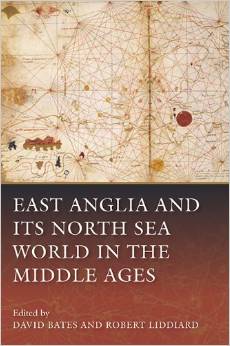East Anglia and its North Sea World in the Middle Ages
Edited by David Bates and Robert Liddiard
 For much of the Middle Ages, England was not yet unified. Instead, it was made up of several smaller kingdoms, one of which was East Anglia, now made up of Norfolk and Suffolk counties. East Anglia, unlike the rest of its English neighbors, had strong connections and cultural ties to other kingdoms along the North Sea, making it part of the North Sea world. In this book, editors Bates and Liddiard not only explore East Anglia in particular, but also successfully introduce how the North Sea can be studied in much the same way as the Mediterranean and Atlantic worlds.
For much of the Middle Ages, England was not yet unified. Instead, it was made up of several smaller kingdoms, one of which was East Anglia, now made up of Norfolk and Suffolk counties. East Anglia, unlike the rest of its English neighbors, had strong connections and cultural ties to other kingdoms along the North Sea, making it part of the North Sea world. In this book, editors Bates and Liddiard not only explore East Anglia in particular, but also successfully introduce how the North Sea can be studied in much the same way as the Mediterranean and Atlantic worlds.
The book is based off papers from the 2010 East Anglia and the North Sea World Conference. The goal of the conference was to establish that the North Sea world, including the Baltic Sea to the east, could be studied using a similar model to studies from the Mediterranean and Atlantic Worlds. Northern Europe differed greatly from southern Europe in character and identity. Thus, studies specific to the Mediterranean world give no particular insight into the world of northern Europe. As Atlantic world studies continue, their focus is geared toward colonial and post-colonial effects in Europe, West Africa, and the Americas.
This book introduces the North Sea as having a separate regional identity from the rest of Europe. Using the Annales approach, the editors examine how East Anglia fits in and represents the broader regional context. The chapters of the book offer an interdisciplinary look at East Anglia. Though history and archaeology are represented more than others, the fields of geography, art history, and architectural history are also represented. The book is divided into three parts which deal with overviews of East Anglia in the North Sea world, trade and economy, and cultural influences and links, respectively. From brooches and burials to churches and manuscripts, the chapters offer detailed and persuasive arguments, taking the micro to the macro and showing the connections East Anglia had to a broader North Sea character and identity.
One large weakness the book suffers from is the lack of a general or political map of East Anglia. The maps that are present are chapter specific and, without any prior knowledge of East Anglia, readers can quickly become mired in the place names. Perhaps the largest weakness of the book is that the editors assume the reader already has some knowledge of northern European and East Anglian history during the Middle Ages. Thus, readers who are new students to the subject will find this text more confusing than helpful. For researchers and knowledgeable students, however, the book offers a wealth of cases studies specific to East Anglia.
The book represents an interesting model of looking at East Anglia and the North Sea world, despite gaps in the early documentary and archaeological records. Researchers and students can hope that more studies like this will be published in the future, to further examine how the North Sea had its own identity and how East Anglia may have influenced other kingdoms in northern Europe.
- Woodbridge, Suffolk: The Boydell Press, 2013
- 7” x 10”, hardcover, xi + 349 pages
- Illustrations, maps, tables, notes, index. $99.00
- ISBN: 9781843838463
Reviewed by Adam K. Parker, East Carolina University
